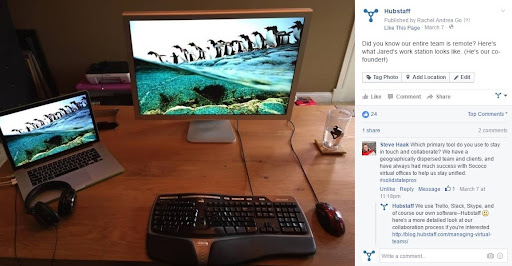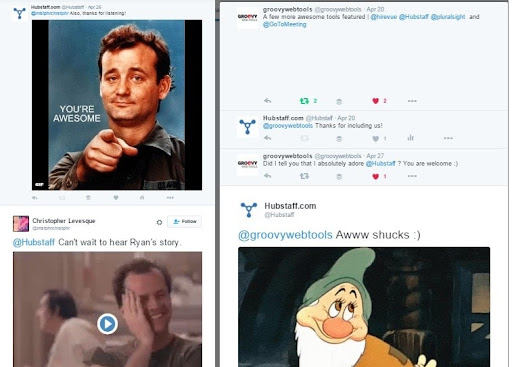

To anyone who has had to plan and execute a social media strategy, you understand how hard it is to stay on top of the ever-changing social media landscape. Social networks are constantly rolling out new features, and it’s important to distinguish passing industry fads from trends that can spur growth.
In this post, I’ll show you that there’s a significant benefit to investing your time in developing and implementing a social media strategy. If you read through to the end, you’ll learn how to develop a social media strategy that has the potential to drive significant traffic to your website.
We’ll go over how our social media strategy went from an afterthought to a priority and got our blog and website 230% more monthly visitors from social media.
Our Social Media Began As No Man’s Land
Social media is a new convergence of marketing and customer support, a tool that is an equal part of the sales, support, and marketing worlds.
At Hubstaff, there was initially very little in that area that was being done. We had an excellent advertising expert who took care of social advertising, but without good content, there was only so much he could do.
I was more heavily involved in the blog than anything else. One of my to-dos for each blog post that went live was to share it on social media via the Buffer app.
However, this meant that our social channels were dominated by our own content (not biased at all and totally credible, right?) instead of great, relevant information from all around the internet. There was almost no difference between visiting our Facebook and Twitter pages and our blog homepage.
This was a huge mistake because people were reaching out to us on social media. Our page was relatively quiet (aside from trying to broadcast our blog posts), and it had the personality of a snail. Whenever we had a visitor check out our profiles, instead of hitting the follow or like buttons, they’d see our monotonous content and bounce.
Gathering Data And Establishing Guidelines
To be perfectly honest, I had handled social media pages before, but I was no strategist. I created content for social media and scheduled it to go out. I hadn’t dealt with social editorial calendars, analytics, creating guidelines, or anything like that.
Thankfully, many of my team members knew what they were doing. That first month, I let spam slip by because I didn’t know where to look for it on our Facebook page (whoops), continued posting like an automated bot, and made other embarrassing mistakes.
During this transition period, I developed a few things to help guide me and anyone else who might deal with our social media pages.
The first was a response guidelines document, which covered how to answer questions we got on our social profiles. The second was a tone and voice exercise to try and distill the personality of our brand so I could adjust my writing accordingly. Finally, I compiled all of my duties into a social media checklist to make sure I didn’t forget to do anything each week.
My main goals were:
- Reply to 99% of mentions on Twitter and Facebook
- Delete all spam comments and posts from our Facebook page
- Send out interesting, useful, and relevant content through our social channels
Overall, for the first few months, I had responsibility for our social media strategy, I was reactive rather than proactive. That changed when we got some professional advice from a social media consultant.
Working With a Consultant
Our social media consultant is truly fantastic at what she does, and the consulting session we had with her shaped our new social media strategy moving forward. She pointed out what we were doing well and what needed improvement.
For anyone who needs more directly with their social media strategy or is simply not as experienced with social media marketing, I highly recommend getting some expert feedback.
Here’s what we learned from our session with the consultant:
Show benefits, not features
The “About” section on our social media pages was tailored towards us instead of our customers. Our description talked about the company and what we did, but it didn’t explain how we can help potential customers:
“We make remote employee tracking and management easy through time tracking software with screenshots and activity levels.”
Our new description (still a work in progress) now says: “Increase your remote team productivity and make team management a breeze with accurate time tracking, screenshots, GPS tracking, and more.”
Actionable tip: Keep the customer at the center of attention.
Focus on quality over quantity
I was posting too much on Facebook, and it was all links. Our engagement rate was low, and we were basically throwing information at our followers without having any conversations with them. If our engagement was consistently low, our updates would start showing up less on our followers’ newsfeeds, and it would become a vicious cycle.
Sharing links is okay, but the problem with that is that people have to click away from our social media pages in order to gain value. We are redirecting traffic to web pages that aren’t ours instead of engaging with people through our social media pages.
Instead of posting three or four times a day on Facebook, I scaled back to one post a day. I was more lenient with the numbers on Twitter, but rarely did I exceed six tweets in one day (excluding @ mentions).
I also started diversifying the type of content I was posting. I used Canva to create images that I could share on Facebook and Twitter, providing value to our followers without them having to go anywhere else.
Actionable tip: Get your engagement up by posting once or twice a day, and don’t make your viewers go anywhere in order to get value.
Don’t be boring
Easier said than done, I know. But in our case we really were boring. I erred towards the side of professionalism, and that rarely fits on social media. In order to infuse some personality into our social media pages, I started focusing on what Hubstaff had those other companies couldn’t share.
Here are a few things I came up with:
- We have a 100% remote team, with team members sharing their opinions about time tracking software and remote work productivity.
- We share our journey through our growth posts, which document our failures and successes on our journey to grow Hubstaff.
- Our team travels quite a bit. We’re all over America, Asia, Europe, etc. I never get tired of seeing what the team is up to in our team calendar or hearing about their adventures on Slack.
I took the blog posts that showcased our team’s unique view of remote work and spun them into images, which I shared on our social media pages.
I highlighted our devotion to remote work and let people peek a little more into our company culture. This image of Jared’s (our co-founder) workplace did well on both Facebook and Twitter.

I also started sharing our customer success stories and testimonials taken from our case studies. It’s always great hearing the nice things people say about Hubstaff, and sharing that out to our social followers both strengthened the brand and added to our credibility.
In the future, I’d like to post photos of the cool places our team is working from.
Actionable tip: Get personal and share tips and experiences that are unique to your brand.
The consultant’s advice gave me a great place to start improving our social media marketing efforts. I began replying to every tweet, sometimes with GIFs (more on that later), tagging relevant companies and people on Twitter and Facebook, and starting conversations with our followers.
I put much more thought into what I was sharing, and I’ve seen engagement rates rise and how funny some of our followers (and fellow brands) can be.
Our Current Social Media Strategy Focuses on Personality and Value
We are more human in our communication. I read every tweet and respond to almost all of them (the exceptions are trolls or tweets that are way out there and make no sense), plus I have three levels of alerts set up, so I don’t miss any mention of us that we weren’t tagged in. For these, I use Mention, Notify, and Google Alerts.
One of the best things I discovered handling Hubstaff’s social media accounts is the joy of GIFs.

We have a heavier focus on customer satisfaction now. In fact, we connected our Facebook and Intercom accounts so that all Facebook messages get sent directly to our support team. That means all the technical questions that I’m unable to address go straight to the people who can, cutting out the middleman and allowing us to get questions answered more quickly.
Our strategy is ever-evolving. We scale and grow with a process of trial and error. We’re observing what our audience enjoys, what they find useful, and the content they engage with.
What I Learned
Social media has evolved from being simply a channel to reach your target audience into a method for developing relationships and providing value. When I first started working with social media, its potential was lost on me. Six months ago, I would have only seen one or two people sharing our content or reaching out to us online every few weeks.
Today, I regularly send out thank you notes to great people who share our articles and engage with us through social media. The response has been amazing, and the opportunities are expanding as we reach out to influencers and other great remote teams to talk about collaboration and chat about our experiences so far.
[“source=digitalagencynetwork”]

